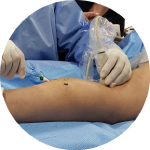
Constantino S. Peña, MD, FSIR, gives a brief overview of options for mechanical thrombectomy.
Constantino S. Peña, MD, FSIR, presented a session on Vacuum-Assisted Venous Thrombectomy: When, Why, How? at a recent International Vein Congress. He kicked off the brief talk by noting that there are more than 25 devices available for mechanical thrombectomy, and it's a highly competitive market space. That market continues to expand in the areas such as deep vein thrombosis and pulmonary embolism.
"I think we're still trying to find the ideal one, particularly in the venous system," he said. The variety of techniques includes both conventional and ultrasound-assisted catheter-directed thrombolysis (CDT), as well as mechanical options such as fragmentation, rheolytic thrombectomy, vacuum-assisted thrombectomy, suction devices and extraction devices. He chose to focus on vacuum-assisted and suction devices. The large vessels of the venous system, he noted, can have a significant amount of embolic load. "And if we believe in that open vein theory, the more clot we can get out may be the best results we can get, in terms of the patient's symptoms."
Mechanical treatments are needed, Dr. Peña said, because not everyone can get thrombolysis. There might also be a faster response, and the work might be done in a single session. From there, Dr. Peña explored different options. Catheters, for example, are most suited to removing small amounts of thrombus in the arterial system; they're very limited, however, in the venous system, because of the inability to apply a constant, significant amount of vacuum for aspiration. Devices are available that allow the creation of vacuum by hand, but questions remain about how constant that suction will be.
On the other end of the spectrum is the AngioVac cannula and circuit. "You're able to basically place the patient on bypass," he said. "You're taking blood out through one way and putting it back in after you filter it through another access site. But you're able to deal with a significant amount of thrombus."
He also mentioned the Penumbra Indigo System, which includes a pump delivering continuous vacuum; when used with a catheter, that pressure allows for significant aspiration in a vessel.
Dr. Peña touched on case studies. With pulmonary arteries, he said, "you're not looking for a huge amount of clots, like you might see in other areas." But procedures can still be effective in lowering pressures.
The video, available at Vein Global, is one of more than 200 on-demand instructional, inspirational and innovative presentations by leading venous professionals. Learn more and subscribe at VeinGlobal.com.
Recent Posts

Review of Radiofrequency Ablation Devices

Overtreatment in CVD Leads to Superficial Ablation Abuse

Ultrasound-guided Foam Sclerotherapy

Recurrent Stent Occlusion: Endovenectomy, Bypass, or Compression Only

Optimizing Deep Vein Images: The Profunda Femoris Vein

A Closer Look at Swollen Legs: Edema Differentiation

Vein Global and IVC are Evolving to Launch the Next Decade of Endovascular Innovation and Education

Phlebectomy: Technical Steps with Jose I. Almeida, MD, FACS, RPVI, RVT

The Spectrum of Vacuum-Assisted Venous Thrombectomy

Sclerotherapy: Technical Steps with Julian J. Javier, MD, FSCAI, FCCP

